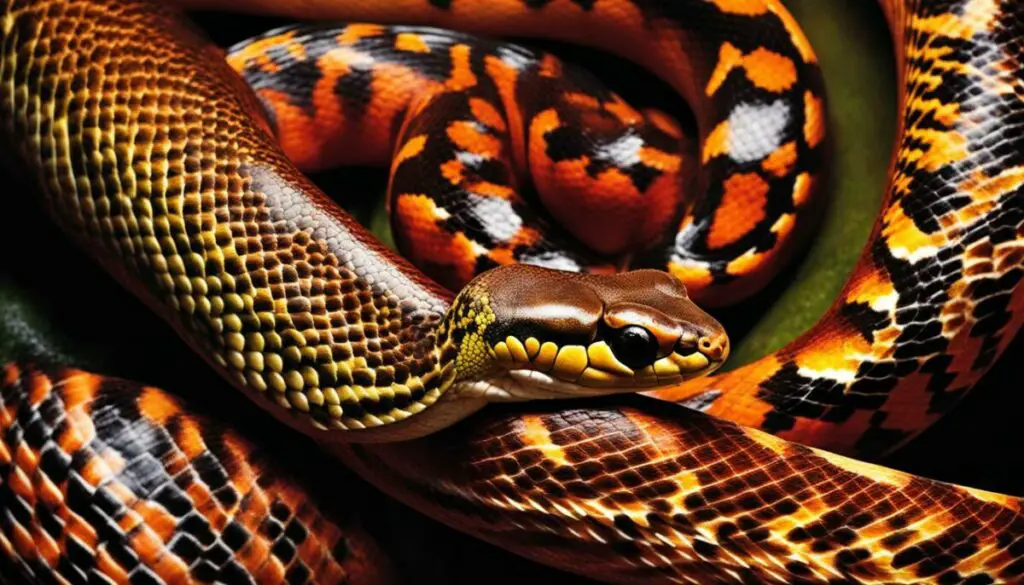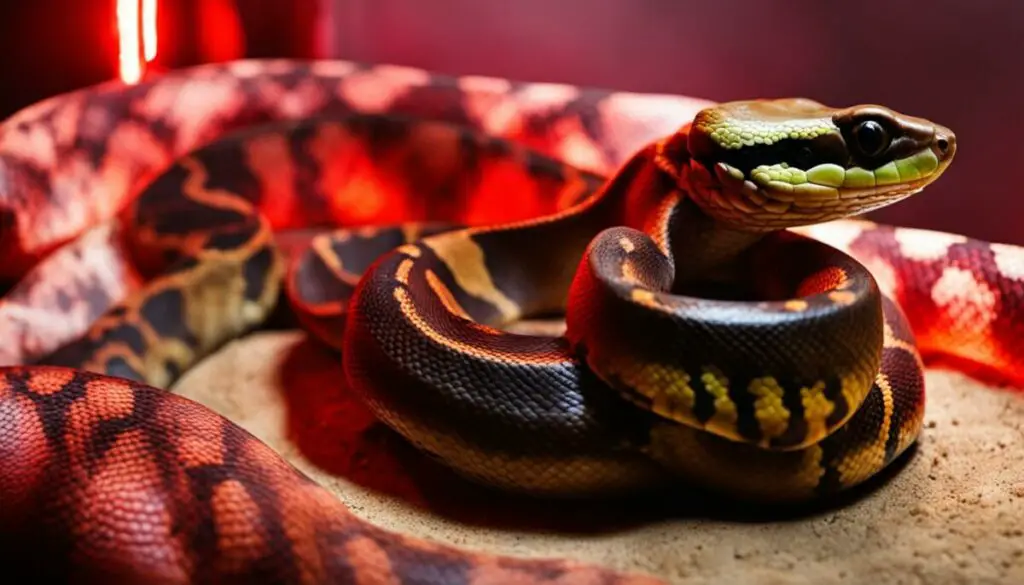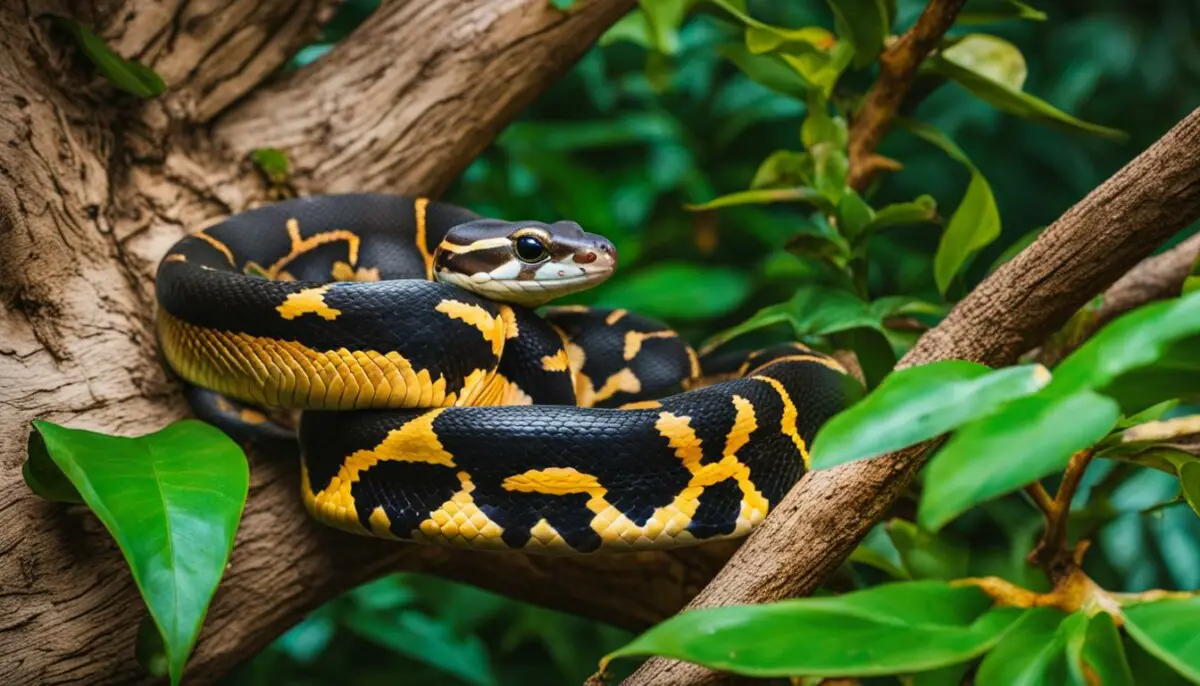Last Updated on 5 months by Francis
Have you ever wondered if ball pythons have the ability to see infrared light? In this article, we’ll delve into the fascinating world of snake vision and explore the truth behind their perception of infrared light. Understanding how ball pythons see the world can provide valuable insights into their behavior and care.
Contents
Key Takeaways:
- Ball pythons do not see red light as they are dichromatic and can only see color in the green and blue spectrum.
- They have specialized heat-sensing organs called pit organs that can detect infrared radiation.
- Artificial lighting in ball python enclosures is not necessary but can provide benefits such as proper heat regulation and simulation of day/night cycles.
- It is important to choose the right type of lighting and follow proper usage guidelines to ensure the snake’s health and well-being.
Understanding the Visual System of Ball Pythons

Ball pythons, like many snakes, have a unique visual system that allows them to navigate their environment and locate prey. While they do not see infrared light in the traditional sense, they possess specialized heat-sensing organs called pit organs. These organs, located between their eyes and nostrils, enable them to detect infrared radiation emitted by warm-blooded prey.
The pit organs of ball pythons are highly sensitive and can detect even subtle changes in temperature. This infrared vision is crucial for their survival, as it helps them accurately locate and strike their prey. However, the exact process by which ball pythons convert the infrared signals detected by their pit organs into nerve impulses is still not fully understood.
It is fascinating to observe the evolutionary adaptations that have led to the development of these unique sensory organs in snakes. The ability to detect heat and sense infrared radiation has allowed ball pythons and other snakes to thrive as predators for millions of years. Continued research in this field will undoubtedly shed more light on the intricacies of snake vision and the evolutionary changes that have shaped it.
Table: Comparing Snake Vision to Human Vision
| Aspect | Snake Vision | Human Vision |
|---|---|---|
| Color Perception | Limited to green and blue spectrum | Full color vision |
| Infrared Detection | Pit organs detect infrared radiation | Not capable of detecting infrared |
| Visual Acuity | Lower than humans | Higher than snakes |
| Depth Perception | Relies on binocular vision | Enhanced due to two forward-facing eyes |
Ball Python Enclosure Lighting: Finding the Right Balance
Creating a suitable lighting environment in a ball python enclosure is essential for their well-being. While natural indirect light from a nearby window can suffice, in colder countries or environments lacking natural light, additional artificial lighting may be necessary. It is important to strike a balance between providing warmth and simulating day/night cycles without disrupting the snake’s natural behaviors. Let’s explore the role of light in ball python enclosures and the different lighting options available.
Types of Lighting for Ball Pythons
| Lighting Type | Advantages | Considerations |
|---|---|---|
| Incandescent Heat Lights | Provide heat, relatively inexpensive | Potential for burns, reduced humidity |
| UVB Fluorescent Lights | Slightly improve health, beneficial for bioactive setups | Excessive exposure can be harmful, higher upfront cost |
| LED Lights | Energy-efficient, easy to use, long-term cost savings | May not provide sufficient heat, higher upfront cost |
By understanding the advantages and considerations of each lighting type, you can make an informed decision for your ball python’s enclosure. It is crucial to prioritize the snake’s safety and comfort when choosing the lighting option.
Types of Lights for Ball Pythons
When it comes to providing lighting for ball pythons, there are several types of lights to consider. Each type has its own advantages and considerations, so it’s important to choose the right one based on your snake’s needs and your specific setup.
Incandescent Heat Lights
Incandescent heat lights are a popular choice for providing heat in ball python enclosures. These lights emit infrared radiation, which helps to create a warm basking spot for your snake. However, it’s important to use caution with these lights, as they can get very hot and may pose a risk of burns to your snake if not properly positioned or controlled.
Additionally, incandescent heat lights can also increase the temperature in the enclosure, which may lead to a decrease in humidity. This can be problematic for ball pythons, as they require a certain level of humidity to maintain good health. To prevent this, it’s recommended to use these lights in conjunction with a thermostat to regulate the temperature and a hygrometer to monitor humidity levels.
UVB Fluorescent Lights
UVB fluorescent lights are another option to consider for ball python lighting. While ball pythons do not necessarily require UVB lighting, these lights can provide some benefits to their overall health. UVB light helps reptiles, including ball pythons, produce vitamin D3, which aids in calcium absorption and overall bone health.
When using UVB fluorescent lights, it’s essential to follow proper timing and dosage guidelines to avoid overexposure. Excessive exposure to UVB light can be harmful to snakes, so it’s recommended to set these lights on a timer for a 12-hour cycle and choose a UVB bulb that is appropriate for your snake’s enclosure size.
LED Lights
LED lights are becoming increasingly popular for reptile lighting, including ball pythons. These lights are energy-efficient, long-lasting, and provide a bright and natural-looking light source. LED lights are also easy to install and regulate, making them a convenient option for snake owners.
However, it’s important to note that LED lights may not provide sufficient heat for ball pythons, especially in colder environments. It’s recommended to use LED lights in combination with other heat sources, such as heat pads or ceramic heat emitters, to ensure that your snake’s enclosure maintains the proper temperature gradient.
| Light Type | Advantages | Considerations |
|---|---|---|
| Incandescent Heat Lights | – Provide heat for basking | – Risk of burns if not used properly – Can decrease humidity |
| UVB Fluorescent Lights | – Aid in vitamin D3 production – Improve calcium absorption |
– Proper timing and dosage is crucial – Overexposure can be harmful |
| LED Lights | – Energy-efficient and long-lasting – Bright and natural-looking light |
– May not provide sufficient heat – Use in combination with other heat sources |
Each type of light has its own benefits and considerations, so it’s essential to assess your specific setup and the needs of your ball python before making a decision. Ultimately, the right lighting choice will provide the proper heat and lighting conditions for your snake, promoting their overall health and well-being.
Benefits and Risks of Incandescent Heat Lights

Incandescent heat lights are commonly used for providing warmth in ball python enclosures. These lights emit infrared radiation, which helps create a basking spot for the snake to regulate its body temperature. There are several benefits to using incandescent heat lights:
- Effective heat source: Incandescent heat lights can provide a steady heat source, creating a temperature gradient within the enclosure. This allows ball pythons to thermoregulate by moving between warmer and cooler areas as needed.
- Relatively inexpensive: Compared to other lighting options, incandescent heat lights are generally more affordable and readily available.
- Easy to install: Incandescent heat lights can be easily set up with a lamp fixture and bulb, making them convenient for snake keepers.
However, it is important to be aware of the potential risks associated with using incandescent heat lights:
- Burns: Incandescent bulbs can become very hot, increasing the risk of burns if the snake comes into direct contact with the bulb or gets too close to it. It is crucial to use appropriate bulb wattage, provide adequate distance between the bulb and the snake, and use a protective cage or cover to prevent accidental contact.
- Reduced humidity: Incandescent heat lights can contribute to lower humidity levels in the enclosure, which can be problematic for ball pythons who require a humid environment for proper shedding and overall health. Additional measures, such as misting the enclosure or using a humidifier, may be necessary to maintain adequate humidity levels.
- Increased energy consumption: Incandescent bulbs tend to consume more energy compared to other lighting options, resulting in higher long-term costs.
| Benefits of Incandescent Heat Lights | Risks of Incandescent Heat Lights |
|---|---|
| – Effective heat source | – Risk of burns |
| – Relatively inexpensive | – Reduced humidity |
| – Easy to install | – Increased energy consumption |
“Incandescent heat lights are a popular choice among snake owners for their affordability and heat-providing capabilities. However, it is important to take precautions to prevent burns and monitor humidity levels to ensure the well-being of the ball python.”
It is recommended to consult with a reptile expert or veterinarian to determine the best lighting and heating setup for your ball python’s specific needs and environmental conditions. By understanding the benefits and potential risks of incandescent heat lights, snake keepers can create a comfortable and safe habitat for their beloved reptiles.
Benefits and Risks of LED Lights
LED lights are a popular lighting option for ball python enclosures due to their energy efficiency and ease of use. They offer a brighter and more vibrant lighting compared to traditional incandescent bulbs. LED lights also have the advantage of saving on long-term costs as they consume less energy.
One of the main benefits of using LED lights is their durability and longevity. They have a longer lifespan compared to other types of lighting, reducing the need for frequent replacements. LED lights also produce very little heat, making them safer for the snake and reducing the risk of burns.
However, it is important to note that LED lights may not provide sufficient heat for proper basking temperatures in colder environments. They are primarily designed for illumination rather than heat generation. Therefore, if additional warmth is required in the enclosure, a supplemental heat source may be necessary.
| Benefits of LED Lights | Risks of LED Lights |
|---|---|
| Energy-efficient | Insufficient heat production |
| Long lifespan | May require additional heat source |
| Bright and vibrant lighting |
To ensure the well-being of the ball python, LED lights should be set on a timer to establish appropriate day/night cycles. The intensity of the lighting should also be carefully chosen to avoid excessive brightness, which can cause stress for the snake. Overall, LED lights can be a beneficial lighting option for ball pythons when used in conjunction with proper heat sources to create a comfortable and stimulating environment.
Benefits and Risks of UVB Fluorescent Lights
UVB fluorescent lights, although not necessary for ball pythons, can offer several benefits for their overall health and well-being. These lights emit UVB radiation, which helps ball pythons increase their Vitamin D levels and aids in calcium absorption. UVB light is essential for reptiles as it enables them to metabolize calcium, which is crucial for proper bone development and overall bodily functions.
One of the advantages of using UVB fluorescent lights is that they provide adequate lighting without excessive brightness. This is important as ball pythons are naturally nocturnal and prefer dimly lit environments. UVB lights can help create a more naturalistic habitat for the snake, allowing them to exhibit their natural behaviors and promote overall physiological well-being.
However, it is important to exercise caution when using UVB fluorescent lights. Excessive exposure to UVB radiation can be harmful to ball pythons and may lead to health issues such as eye damage or sunburn. It is essential to follow proper timing and dosage guidelines to prevent any harm to the snake. Typically, UVB bulbs are set on a timer to provide controlled exposure for a 12-hour cycle, replicating the natural day and night cycle in the snake’s enclosure.
| Benefits of UVB Fluorescent Lights for Ball Pythons: | Risks of UVB Fluorescent Lights for Ball Pythons: |
|---|---|
|
|
When considering the use of UVB fluorescent lights for ball pythons, it is crucial to strike a balance between providing the necessary benefits and avoiding potential risks. Consulting a reptile veterinarian or an experienced reptile keeper can provide valuable guidance and ensure the well-being of your ball python.
Lights to Avoid for Ball Pythons
When it comes to providing lighting for ball pythons, it’s important to choose options that are safe and suitable for their needs. However, there are certain types of lights that should be avoided as they can be harmful to the snake. Let’s take a look at two types of lights that are not recommended for ball pythons: halogen light bulbs and UVC light bulbs.
The Dangers of Halogen Light Bulbs
Halogen light bulbs are known for producing intense heat and brightness, which can be detrimental to ball pythons. These bulbs can lead to overheating in the enclosure, posing a risk of burns and discomfort for the snake. Additionally, the high levels of brightness can cause stress and anxiety for the snake, as they prefer dimmer environments. It is best to avoid using halogen light bulbs when providing lighting for ball pythons.
The Hazards of UVC Light Bulbs
UVC light bulbs, typically used as disinfectants, emit a type of ultraviolet light that can be extremely harmful to ball pythons. Even at low dosages, UVC light can cause severe tissue damage to the snake, resulting in burns and other serious health issues. It is crucial to steer clear of UVC light bulbs when selecting lighting options for ball pythons to ensure their safety and well-being.
| Type of Light Bulb | Dangers |
|---|---|
| Halogen Light Bulbs | Produce intense heat and brightness, leading to burns and stress for the snake. |
| UVC Light Bulbs | Emits ultraviolet light that can cause severe tissue damage and serious health issues for the snake. |
When it comes to lighting options for ball pythons, it is always better to prioritize their safety and well-being. By avoiding halogen light bulbs and UVC light bulbs, you can ensure that your ball python remains healthy and comfortable in its enclosure.
Evolutionary Insights and Adaptations of Snake Vision
Snake vision has evolved over millions of years, allowing these remarkable creatures to excel as efficient predators. One of the most fascinating adaptations in snake vision is the development of specialized organs called pit organs. These pit organs, located between the eyes and nostrils, enable snakes to sense infrared radiation and detect the heat emitted by warm-blooded prey. This evolutionary innovation has given snakes a distinct advantage in hunting, making them formidable predators in their habitats.
The evolution of pit organs in snakes is a remarkable example of nature’s ingenuity. These organs are highly sensitive and can detect even the slightest variations in temperature. By perceiving the infrared radiation emitted by potential prey, snakes can accurately locate their targets, even in complete darkness. This ability provides them with a significant advantage over their prey, making it easier for them to hunt and survive in various environments.
Throughout evolution, snakes have undergone changes in their sensory molecules, allowing them to adapt to different environments and hunting strategies. The intricate neurochemical pathway involved in heat detection has been an essential component of snake vision. By understanding this pathway, scientists have gained valuable insights into the evolutionary history of snake vision and the sensory adaptations that have shaped it.
“The ability of snakes to sense infrared radiation and detect heat is an evolutionary adaptation that has allowed them to thrive as predators for over 100 million years.”
Studying the evolution of snake vision and the development of pit organs provides not only a deeper understanding of these fascinating creatures but also broader insights into the evolution of sensory systems in general. By unraveling the genetic and molecular mechanisms behind snake vision, scientists can gain valuable knowledge that may have implications for other species and fields of study. The study of snake vision continues to shed light on the remarkable adaptations that have allowed these creatures to survive and thrive for millions of years.
| Snake Vision Evolution | Pit Organ Evolution |
|---|---|
| Snakes have developed specialized vision adaptations to detect heat and sense infrared radiation. | The evolution of pit organs has allowed snakes to accurately locate warm-blooded prey. |
| Changes in sensory molecules have contributed to the adaptability of snake vision in different environments. | Pit organs are highly sensitive and can detect even slight temperature variations. |
| Understanding the neurochemical pathway involved in heat detection provides insights into the evolution of snake vision. | The development of pit organs has shaped the sensory adaptations of snakes. |
The Importance of Proper Lighting for Ball Pythons
Proper lighting is essential for the health and well-being of ball pythons. While they do not necessarily require artificial lighting, providing a suitable light source in their enclosure can offer several benefits. One of the key advantages of proper lighting is heat regulation. Ball pythons, like other reptiles, rely on external heat sources to maintain their body temperature. A well-placed heat lamp or light can create a warm spot in the enclosure where the snake can bask and thermoregulate.
In addition to heat regulation, proper lighting also helps simulate natural day and night cycles for ball pythons. These cycles play a crucial role in their overall behavior and physiology. By providing a consistent light-dark cycle, you can help establish a regular routine for your snake, promoting better feeding and sleeping patterns. This can contribute to a healthier and more contented ball python.
When it comes to choosing the right type of light for your ball python, it’s important to consider their specific needs. Some lighting options, such as incandescent heat lights, provide both heat and light. However, they may increase the risk of burns and reduce humidity in the enclosure. LED lights, on the other hand, are energy-efficient and easy to use, but they may not provide sufficient heat for colder environments. UVB fluorescent lights can slightly improve a ball python’s health, but excessive exposure can be harmful.
Table: Comparison of Lighting Options for Ball Pythons
| Lighting Option | Advantages | Considerations |
|---|---|---|
| Incandescent Heat Lights | Provide heat and light | Potential for burns and reduced humidity |
| LED Lights | Energy-efficient, easy to use | May not provide sufficient heat |
| UVB Fluorescent Lights | Slightly improve health | Possible harm with excessive exposure |
It’s crucial to find a balance between providing the necessary light and heat without compromising the snake’s safety. Using a thermostat and timer for both light and heat fixtures is highly recommended. This ensures that the temperature and light cycles remain consistent and within the optimal range for your ball python’s well-being.
Remember, if you’re unsure about the best lighting option for your ball python, consult with a reptile veterinarian or an experienced reptile keeper. They can provide guidance based on your specific circumstances and help you create an optimal lighting setup for your beloved snake.
Conclusion
In conclusion, proper lighting in ball python enclosures plays a crucial role in maintaining the health and well-being of these fascinating reptiles. While ball pythons have limited ability to see infrared light, they rely on their specialized pit organs to detect heat, which helps them locate prey.
Choosing the right lighting option for your ball python is essential. Incandescent heat lights can provide warmth but require caution to prevent burns and reduce humidity. LED lights offer energy-efficiency and ease of use, but may not provide sufficient heat for colder environments. UVB fluorescent lights, though not necessary, can slightly enhance the snake’s health but require proper timing and dosage. It is important to avoid harmful light bulbs such as halogen and UVC, which can be detrimental to the snake’s well-being.
Ultimately, providing suitable lighting for your ball python can help regulate temperature, simulate day/night cycles, and create a comfortable environment. By following proper usage guidelines and considering the specific needs of your snake, you can ensure their overall health and happiness. So, make an informed decision when it comes to lighting your ball python enclosure and provide your slithery friend with the best possible care.
FAQ
Can ball pythons see infrared light?
No, ball pythons do not see red light as they are dichromatic and can only see color in the green and blue spectrum. They have specialized heat-sensing organs called pit organs that allow them to detect infrared radiation and locate warm-blooded prey.
Do ball pythons require artificial lighting in their enclosures?
Ball pythons do not require artificial lighting if they are exposed to natural indirect light from a nearby window. However, in colder countries, an overhead lighting/heat source is recommended to provide additional warmth and simulate day/night cycles.
What types of lights can be used for ball pythons?
There are several types of lights that can be used for ball pythons, including incandescent heat lights, UVB fluorescent lights, and LED lights.
What are the benefits and risks of using incandescent heat lights?
Incandescent heat lights provide heat and can be relatively inexpensive compared to other options. However, they can pose risks such as skin burns, the need for a timer to regulate usage, higher long-term costs due to energy consumption, and reduced humidity in the enclosure.
What are the benefits and risks of using LED lights?
LED lights are energy-efficient and offer ease of use for ball python enclosures. They are brighter than incandescent bulbs and can save on long-term costs. However, they may be too bright for prolonged use and lack sufficient heat for cold environments.
What are the benefits and risks of using UVB fluorescent lights?
UVB fluorescent lights are not required for ball pythons but can slightly improve their health by increasing Vitamin D levels and calcium absorption. However, excessive exposure to UVB light can be harmful, and proper timing and dosage should be followed.
What types of lights should be avoided for ball pythons?
Halogen bulbs and UVC bulbs should be avoided for ball pythons. Halogen bulbs can produce excessive heat and brightness, which can be harmful to the snake. UVC bulbs, typically used as disinfectants, can cause severe tissue damage even at low dosages.
What insights do snake vision and pit organs provide into snake evolution?
The ability of snakes to sense infrared radiation and detect heat through pit organs is an evolutionary adaptation that has allowed them to thrive as predators for over 100 million years. Changes in sensory molecules have contributed to their ability to adapt to different environments and hunting strategies.
How important is proper lighting for ball pythons?
Providing a suitable light source for ball pythons can offer benefits such as proper heat regulation and simulation of day/night cycles. However, it is crucial to choose the right type of light and ensure appropriate usage to prevent harm to the snake.









